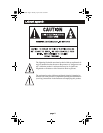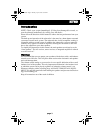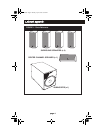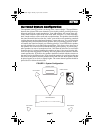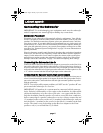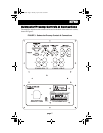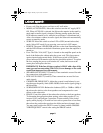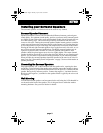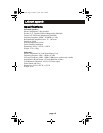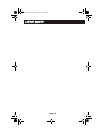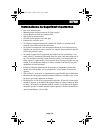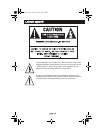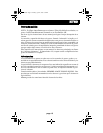
page 8
• Power cord: Plug the power cord into an AC wall outlet.
• MODE (AUTO ON/OFF): Move this switch to turn the AC supply OFF/
ON. When AUTO ON is selected, the Subwoofer remains in the stand-by
mode until an audio signal is detected. (During standby mode, the front
LED indicator remains un-lit, while the rear indicator is illuminated red.)
After a few minutes without an audio signal, the Subwoofer automatically
reverts to stand-by mode.
• SUB/LFE: Move this switch to select LFE or SUB (normal subwoofer)
mode. Select LFE mode if you are using your receiver’s LFE output.
• POWER: The green LED POWER indicator on the front illuminates blue
and the LED indicator on the back illuminates green when the amplifier is
turned on.
• Fuse: The 250v 2.0A (AGC Type) is located on the amplifier panel on the
back of the Subwoofer cabinet under the power cord. This fuse protects
against internal and external faults. If the Power switch is ON but the
power indicator LED remains unlit, the fuse should be replaced. To replace
the fuse, unplug the power cord from the AC outlet, then unscrew the
center piece and replace the fuse.
IMPORTANT: If the fuse is blown, replace it ONLY with a fuse of the
same type and current rating (250v 2.0A). Severe damage or fire could
result from improper fuse replacement.
• SPEAKER LEVEL IN/OUT (L and R): These terminals are used for mak-
ing connections with speaker wire.
• LINE LEVEL IN/OUT (L and R): These connections are used for bass
audio signals.
• CROSSOVER FREQUENCY: Adjust the system’s tonal balance by set-
ting the upper frequency limit (40Hz-180Hz) for the audio signals going to
the subwoofer.
• SUBWOOFER LEVEL: Balance the loudness (OFF, or -30dB to +9dB) of
the subwoofer relative to the front speakers and compensate for room
effects on the subwoofer.
• PHASE: Control the phase of the subwoofer relative to the front speakers.
To determine the appropriate phase setting, select either regular (0°) or
inverted (180°) and perform a sound test. Listen carefully to the sound
quality while playing a CD with low bass such as percussion or bass lines,
then select the position that produces the fullest and most dynamic bass.
You may need to adjust the LEVEL control (volume) and the CROSSO-
VER FREQUENCY control after setting the PHASE switch.
HT60.book Page 8 Monday, April 2, 2007 6:28 PM





